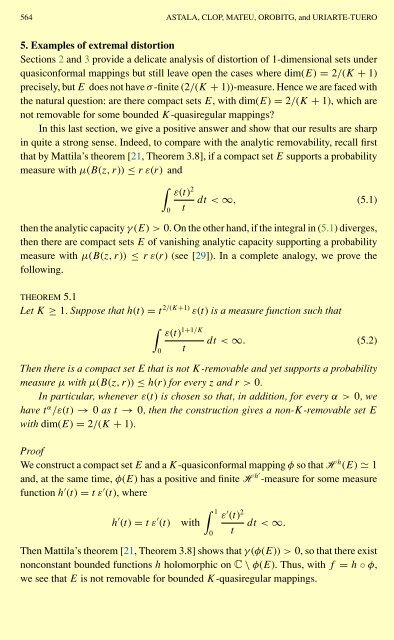A NULLSTELLENSATZ FOR AMOEBAS
A NULLSTELLENSATZ FOR AMOEBAS
A NULLSTELLENSATZ FOR AMOEBAS
You also want an ePaper? Increase the reach of your titles
YUMPU automatically turns print PDFs into web optimized ePapers that Google loves.
564 ASTALA, CLOP, MATEU, OROBITG, and URIARTE-TUERO<br />
5. Examples of extremal distortion<br />
Sections 2 and 3 provide a delicate analysis of distortion of 1-dimensional sets under<br />
quasiconformal mappings but still leave open the cases where dim(E) = 2/(K + 1)<br />
precisely, but E does not have σ -finite (2/(K + 1))-measure. Hence we are faced with<br />
the natural question: are there compact sets E, with dim(E) = 2/(K + 1), which are<br />
not removable for some bounded K-quasiregular mappings?<br />
In this last section, we give a positive answer and show that our results are sharp<br />
in quite a strong sense. Indeed, to compare with the analytic removability, recall first<br />
that by Mattila’s theorem [21, Theorem 3.8], if a compact set E supports a probability<br />
measure with µ(B(z, r)) ≤ rε(r) and<br />
∫<br />
ε(t) 2<br />
dt < ∞, (5.1)<br />
0 t<br />
then the analytic capacity γ (E) > 0. On the other hand, if the integral in (5.1) diverges,<br />
then there are compact sets E of vanishing analytic capacity supporting a probability<br />
measure with µ(B(z, r)) ≤ rε(r) (see [29]). In a complete analogy, we prove the<br />
following.<br />
THEOREM 5.1<br />
Let K ≥ 1. Suppose that h(t) = t 2/(K+1) ε(t) is a measure function such that<br />
∫<br />
ε(t) 1+1/K<br />
dt < ∞. (5.2)<br />
0 t<br />
Then there is a compact set E that is not K-removable and yet supports a probability<br />
measure µ with µ(B(z, r)) ≤ h(r) for every z and r>0.<br />
In particular, whenever ε(t) is chosen so that, in addition, for every α>0, we<br />
have t α /ε(t) → 0 as t → 0, then the construction gives a non-K-removable set E<br />
with dim(E) = 2/(K + 1).<br />
Proof<br />
We construct a compact set E and a K-quasiconformal mapping φ so that H h (E) ≃ 1<br />
and, at the same time, φ(E) has a positive and finite H h′ -measure for some measure<br />
function h ′ (t) = tε ′ (t), where<br />
h ′ (t) = tε ′ (t)<br />
with<br />
∫ 1<br />
0<br />
ε ′ (t) 2<br />
dt < ∞.<br />
t<br />
Then Mattila’s theorem [21, Theorem 3.8] shows that γ (φ(E)) > 0, so that there exist<br />
nonconstant bounded functions h holomorphic on C \ φ(E). Thus, with f = h ◦ φ,<br />
we see that E is not removable for bounded K-quasiregular mappings.
















